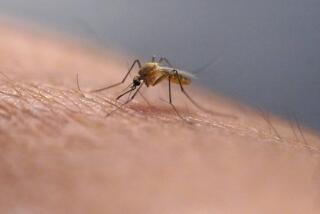West Nile threat grows locally
- Share via
Jack Austin doesn’t remember a mosquito biting him. The 72-year-old Duarte resident also doesn’t remember the nine days he spent in the hospital in July or much of the 20 days he spent in rehab in August, recovering from West Nile neuroinvasive disease.
“One day I was fine, and the next day I fell and hit my head and was out of it,” he said. “The virus came on -- boom -- and it hit me fast.”
An artist who used to swim daily and play basketball, Austin is back home now and walking again, but with a cane. Though progress is slow, he expects to fully recover.
But as Los Angeles County reported its first West Nile virus death of the year Friday, Austin’s sister, Elaine Wille, shared health officials’ concerns that Southern Californians have become complacent about the mosquito-transmitted disease.
“I know you can have a heart attack and die,” Wille said. “But a mosquito bite?”
Statewide, there have been four deaths so far this year, all in Southern California, including two in Orange County and one in San Bernardino County. The peak season for infections is from August to October.
The Los Angeles County man who died earlier this month was 83 and lived in the southeastern part of the county. County officials did not release a name or other details.
About 20% of those infected get the most serious, neuroinvasive form of the disease, which can cause encephalitis, meningitis and death. People older than 50 and the chronically ill are most at risk.
The year is shaping up to be the worst in Southern California since 2004. West Nile infections are up 50% in L.A. County from last year, according to Dr. Jonathan Fielding, county director of public health.
Officials recommend that people use insect repellent, put screens on their windows and get rid of standing water.
West Nile is primarily a bird disease, transmitted among birds -- and to humans -- by mosquitoes. One of the ways public health officials track the movement of the virus is by counting dead birds, and those numbers are also up this year.
The virus first arrived in the northeast United States in 1999, and in California in 2003. In 2004, 779 Californians became infected and 29 died.
In 2005 and 2006, the number of cases and deaths declined, but began rising again last year. Scientists don’t really understand why because the virus is still too new to the area.
One factor may be that the bird population is just now recovering after so many deaths in 2004, increasing the reservoir for the virus, said Kenn Fujioka, assistant manager of the San Gabriel Valley Mosquito and Vector Control.
And then there are the abandoned swimming pools at foreclosed houses, which provide a perfect breeding ground for mosquitoes.
The foreclosure crisis has another effect on mosquito control, or at least it will. Statewide, vector control districts are funded though property taxes or assessments, which already are dropping along with housing prices.
“We’re near the end of this mosquito control season,” said David Brown, manager of the Sacramento-Yolo County Mosquito and Vector Control District. “But next year, we’re going to start seeing an impact.”
--
More to Read
Sign up for Essential California
The most important California stories and recommendations in your inbox every morning.
You may occasionally receive promotional content from the Los Angeles Times.










